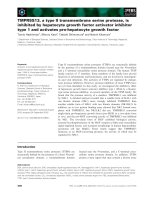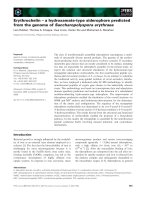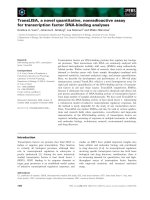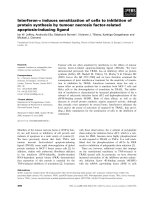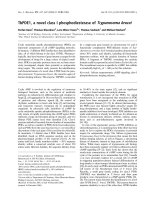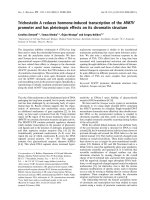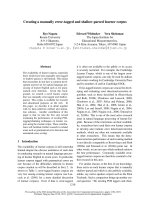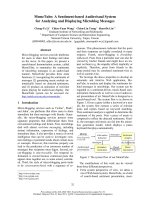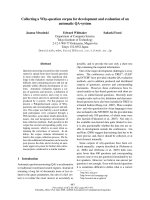Báo cáo khoa học: "Transonics: A Practical Speech-to-Speech Translator for English-Farsi Medical Dialogues" docx
Bạn đang xem bản rút gọn của tài liệu. Xem và tải ngay bản đầy đủ của tài liệu tại đây (347.26 KB, 4 trang )
Proceedings of the ACL Interactive Poster and Demonstration Sessions,
pages 89–92, Ann Arbor, June 2005.
c
2005 Association for Computational Linguistics
Transonics: A Practical Speech-to-Speech Translator for English-Farsi
Medical Dialogues
Emil Ettelaie, Sudeep Gandhe, Panayiotis Georgiou,
Kevin Knight, Daniel Marcu, Shrikanth Narayanan ,
David Traum
University of Southern California
Los Angeles, CA 90089
, ,
, ,
, ,
Robert Belvin
HRL Laboratories, LLC
3011 Malibu Canyon Rd.
Malibu, CA 90265
Abstract
We briefly describe a two-way speech-to-
speech English-Farsi translation system
prototype developed for use in doctor-
patient interactions. The overarching
philosophy of the developers has been to
create a system that enables effective
communication, rather than focusing on
maximizing component-level perform-
ance. The discussion focuses on the gen-
eral approach and evaluation of the
system by an independent government
evaluation team.
1 Introduction
In this paper we give a brief description of a
two-way speech-to-speech translation system,
which was created under a collaborative effort
between three organizations within USC (the
Speech Analysis and Interpretation Lab of the
Electrical Engineering department, the Information
Sciences Institute, and the Institute for Creative
Technologies) and the Information Sciences Lab of
HRL Laboratories. The system is intended to pro-
vide a means of enabling communication between
monolingual English speakers and monolingual
Farsi (Persian) speakers. The system is targeted at
a domain which may be roughly characterized as
"urgent care" medical interactions, where the Eng-
lish speaker is a medical professional and the Farsi
speaker is the patient. In addition to providing a
brief description of the system (and pointers to pa-
pers which contain more detailed information), we
give an overview of the major system evaluation
activities.
2 General Design of the system
Our system is comprised of seven speech and
language processing components, as shown in Fig.
1. Modules communicate using a centralized mes-
sage-passing system. The individual subsystems
are the Automatic Speech Recognition (ASR) sub-
system, which uses n-gram Language Models
(LM) and produces n-best lists/lattices along with
the decoding confidence scores. The output of the
ASR is sent to the Dialog Manager (DM), which
displays the n-best and passes one hypothesis on to
the translation modules, according to a user-
configurable state. The DM sends translation re-
quests to the Machine Translation (MT) unit. The
MT unit works in two modes: Classifier based MT
and a fully Stochastic MT. Depending on the dia-
logue manager mode, translations can be sent to
the unit selection based Text-To-Speech synthe-
sizer (TTS), to provide the spoken output. The
same basic pipeline works in both directions: Eng-
lish ASR, English-Persian MT, Persian TTS, or
Persian ASR, Persian-English MT, English TTS.
There is, however, an asymmetry in the dia-
logue management and control, given the desire for
the English-speaking doctor to be in control of the
device and the primary "director" of the dialog.
The English ASR used the University of Colo-
rado Sonic recognizer, augmented primarily with
LM data collected from multiple sources, including
89
our own large-scale simulated doctor-patient dia-
logue corpus based on recordings of medical stu-
dents examining standardized patients (details in
Belvin et al. 2004).
1
The Farsi acoustic models r e-
quired an eclectic approach due to the lack of ex-
isting labeled speech corpora. The approach
included borrowing acoustic data from English by
means of developing a sub-phonetic mapping be-
tween the two languages, as detailed in (Srini-
vasamurthy & Narayanan 2003), as well as use of
a small existing Farsi speech corpus (FARSDAT),
and our own team-internally generated acoustic
data. Language modeling data was also obtained
from multiple sources. The Defense Language
Institute translated approximately 600,000 words
of English medical dialogue data (including our
standardized patient data mentioned above), and in
addition, we were able to obtain usable Farsi text
from mining the web for electronic news sources.
Other smaller amounts of training data were ob
tained from various sources, as detailed in (Nara-
yanan et al. 2003, 2004). Additional detail on de-
velopment methods for all of these components,
system integration and evaluation can also be
found in the papers just cited.
The MT components, as noted, consist of both a
Classifier and a stochastic translation engine, both
1
Standardized Patients are typically actors who have been
trained by doctors or nurses to portray symptoms of particular
illnesses or injuries. They are used extensively in medical
education so that doctors in training don't have to "practice"
on real patients.
developed by USC-ISI team members. The Eng-
lish Classifier uses approximately 1400 classes
consisting mostly of standard questions used by
medical care providers in medical interviews.
Each class has a large number of paraphrases asso-
ciated with it, such that if the care provider speaks
one of those phrases, the system will identify it
with the class and translate it to Farsi via table-
lookup. If the Classifier cannot succeed in finding
a match exceeding a confidence threshold, the sto-
chastic MT engine will be employed. The sto-
chastic MT engine relies on n-gram
correspondences between the source and target
languages. As with ASR, the performance of the
component is highly dependent on very large
amounts of training data. Again, there were multi-
ple sources of training data used, the most signifi-
cant being the data generated by our own team's
English collection effort, supported by translation
into Farsi by DLI. Further details of the MT com-
ponents can be found in Narayanan et al., op.cit.
3 Enabling Effective Communication
The approach taken in the development of Tran-
sonics was what can be referred to as the total
communication pathway. We are not so concerned
with trying to maximize the performance of a
given component of the system, but rather with the
effectiveness of the system as a whole in facilitat-
ing actual communication. To this end, our design
and development included the following:
MT
English to Farsi
Farsi to English
ASR
English
Prompts or TTS
Farsi
Prompts or TTS
English
ASR
Farsi
GUI:
prompts,
confirmations,
ASR switch
Dialog
Manager
SMT
English to Farsi
Farsi to English
Figure 1: Architecture of the Transonics system. The Dialogue Manager acts as the hub through which the
individual components interact.
90
i. an "educated guess" capability (system
guessing at the meaning of an utterance) from the
Classifier translation mechanism—this proved very
useful for noisy ASR output, especially for the re-
stricted domain of medical interviews.
ii. a flexible and robust SMT good for filling in
where the more accurate Classifier misses.
iii. exploitation of a partial n-best list as part of
the GUI used by the doctor/medic for the English
ASR component and the Farsi-to-English transla-
tion component.
iv. a dialog manager which in essence occa-
sionally makes "suggestions" (for next questions
for the doctor to ask) based on query sets which are
topically related to the query the system believes it
recognized the doctor to have spoken.
Overall, the system achieves a respectable level of
performance in terms of allowing users to follow a
conversational thread in a fairly coherent way, de-
spite the presence of frequent ungrammatical or
awkward translations (i.e. despite what we might
call non-catastrophic errors).
4 Testing and Evaluation
In addition to our own laboratory tests, the sys-
tem was evaluated by MITRE as part of the
DARPA program. There were two parts to the
MITRE evaluations, a "live" part, designed pri-
marily to evaluate the overall task-oriented effec-
tiveness of the systems, and a "canned" part,
designed primarily to evaluate individual compo-
nents of the systems.
The live evaluation consisted of six medical
professionals (doctors, corpsmen and physician’s
assistants from the Naval Medical Center at Quan-
tico, and a nurse from a civilian institution) con-
ducting unrehearsed "focused history and physical
exam" style interactions with Farsi speakers play-
ing the role of patients, where the English-speaking
doctor and the Farsi-speaking patient communi-
cated by means of the Transonics system. Since
the cases were common enough to be within the
realm of general internal medicine, there was no
attempt to align ailments with medical specializa-
tions among the medical professionals.
MITRE endeavored to find primarily monolin-
gual Farsi speakers to play the role of patient, so as
to provide a true test of the system to enable com-
munication between people who would otherwise
have no way to communicate. This goal was only
partially realized, since one of the two Farsi patient
role-players was partially competent in English.
2
The Farsi-speaking role-players were trained by a
medical education specialist in how to simulate
symptoms of someone with particular injuries or
illnesses. Each Farsi-speaking patient role-player
received approximately 30 minutes of training for
any given illness or injury. The approach was
similar to that used in training standardized pa-
tients, mentioned above (footnote 1) in connection
with generation of the dialogue corpus.
MITRE established a number of their own met-
rics for measuring the success of the systems, as
well as using previously established metrics. A
full discussion of these metrics and the results ob-
tained for the Transonics system is beyond the
scope of this paper, though we will note that one of
the most important of these was task-completion.
There were 5 significant facts (5 distinct facts for
each of 12 different scenarios) that the medical
professional should have discovered in the process
of interviewing/examining each Farsi patient. The
USC/HRL system averaged 3 out of the 5 facts,
which was a slightly above-average score among
the 4 systems evaluated. A "significant fact" con-
sisted of determining a fact which was critical for
diagnosis, such as the fact that the patient had been
injured in a fall down a stairway, the fact that the
patient was experiencing blurred vision, and so on.
Significant facts did not include items such as a
patient's age or marital status.
3
We report on this
measure in that it is perhaps the single most im-
portant component in the assessment, in our opin-
ion, in that it is an indication of many aspects of
the system, including both directions of the trans-
lation system. That is, the doctor will very likely
conclude correct findings only if his/her question is
translated correctly to the patient, and also if the
patient's answer is translated correctly for the doc-
tor. In a true medical exam, the doctor may have
2
There were additional difficulties encountered as well, hav-
ing to do with one of the role-players not adequately grasping
the goal of role-playing. This experience highlighted the
many challenges inherent in simulating domain-specific
spontaneous dialogue.
3
Unfortunately, there was no baseline evaluation this could be
compared to, such as assessing whether any of the critical
facts could be determined without the use of the system at all.
91
other means of determining some critical facts
even in the absence of verbal communication, but
in the role-playing scenario described, this is very
unlikely. Although this measure is admittedly
coarse-grained, it simultaneously shows, in a crude
sense, that the USC/HRL system compared fa-
vorably against the other 3 systems in the evalua-
tion, and also that there is still significant room for
improvement in the state of the art.
As noted, MITRE devised a component evalua-
tion process also consisting of running 5 scripted
dialogs through the systems and then measuring
ASR and MT performance. The two primary
component measures were a version of BLEU for
the MT component (modified slightly to handle the
much shorter sentences typical of this kind of dia-
log) and a standard Word-Error Rate for the ASR
output. These scores are shown below.
Table 1: Farsi BLEU Scores
IBM BLEU
ASR
IBM BLEU
TEXT
English to Farsi
0.2664
0.3059
Farsi to English
0.2402
0.2935
The reason for the two different BLEU scores is
that one was calculated based on the ASR compo-
nent output being translated to the other language,
while the other was calculated from human tran-
scribed text being translated to the other language.
Table 2: HRL/USC WER for Farsi and English
English
Farsi
WER
11.5%
13.4%
5 Conclusion
In this paper we have given an overview of the
design, implementation and evaluation of the Tran-
sonics speech-to-speech translation system for nar-
row domain two-way translation. Although there
are still many significant hurdles to be overcome
before this kind of technology can be called truly
robust, with appropriate training and two coopera-
tive interlocutors, we can now see some degree of
genuine communication being enabled. And this is
very encouraging indeed.
6 Acknowledgements
This work was supported primarily by the DARPA
CAST/Babylon program, contract N66001-02-C-
6023.
References
R. Belvin, W. May, S. Narayanan, P. Georgiou, S. Gan-
javi. 2004. Creation of a Doctor-Patient Dialogue
Corpus Using Standardized Patients. In Proceedings of
the Language Resources and Evaluation Conference
(LREC), Lisbon, Portugal.
S. Ganjavi, P. G. Georgiou, and S. Narayanan. 2003.
Ascii based transcription schemes for languages with
the Arabic script: The case of Persian. In Proc. IEEE
ASRU, St. Thomas, U.S. Virgin Islands.
S. Narayanan, S. Ananthakrishnan, R. Belvin, E. Ette-
laie, S. Ganjavi, P. Georgiou, C. Hein, S. Kadambe,
K. Knight, D. Marcu, H. Neely, N. Srinivasamurthy,
D. Traum and D. Wang. 2003. Transonics: A speech
to speech system for English-Persian Interactions,
Proc. IEEE ASRU, St. Thomas, U.S. Virgin Islands.
S. Narayanan, S. Ananthakrishnan, R. Belvin, E. Ette-
laie, S. Gandhe, S. Ganjavi, P. G. Georgiou, C. M.
Hein, S. Kadambe, K. Knight, D. Marcu, H. E.
Neely, N. Srinivasamurthy, D. Traum, and D. Wang.
2004. The Transonics Spoken Dialogue Translator:
An aid for English-Persian Doctor-Patient interviews,
in Working Notes of the AAAI Fall symposium on
Dialogue Systems for Health Communication, pp 97-
-103.
N. Srinivasamurthy, and S. Narayanan. 2003. Language
adaptive Persian speech recognition. In proceedings
of Eurospeech 2003.
92
